Pekka Buttler (Updated 5/2025)
Introduction
To be clear: The Nikon S mount shares 99% of its characteristics with the Contax/Kiev mount. However, there is one subtle difference that lead to that while one can mount Contax/Kiev lenses on Nikon S rangefinders and vice versa, that the rangefinder would always be off by a minor amount.
This was not a mishap and shows that while Nikon Adopted the mount from the Contax Rangefinder and focal plane shutter mechanism from the Leica1, they wanted the Nikon rangefinders to make up a system of its own.
However, due to the overarching similarities between Nikon S and Contax/Kiev mounts (and difference from most other mounts), the rest of this heading will borrow heavily from the JAPB article on the Contax/Kiev mount.
Basic Information on the Nikon S mount
Mount type: Dual Bayonet (inner and outer) (lens release on body (inner bayonet); lens release on lens (outer bayonet)
Flange focal distance: 34,85 mm
Film format: 36mm x 24mm (‘Full frame’)
Mount communication: One internal slotted cam for communicating distance information to camera’s rangefinder apparatus (lens-to-camera).
Nikon S mount specifications
The lens mount is an ingenious, if somewhat quirky, combination of a simple inner bayonet mount that has an integrated rangefinder coupling and integrated focusing, and an outer bayonet mount that does allow using a wide range of focal lengths, but that simultaneously can engage with the rangefinder coupling facilitated by the inner mount. Explaining how this works is easiest if we start by looking at the camera-end of the mount: (NOTE! I will use illustrations from Contax/Kiev as I don’t have a Nikon S on hand.
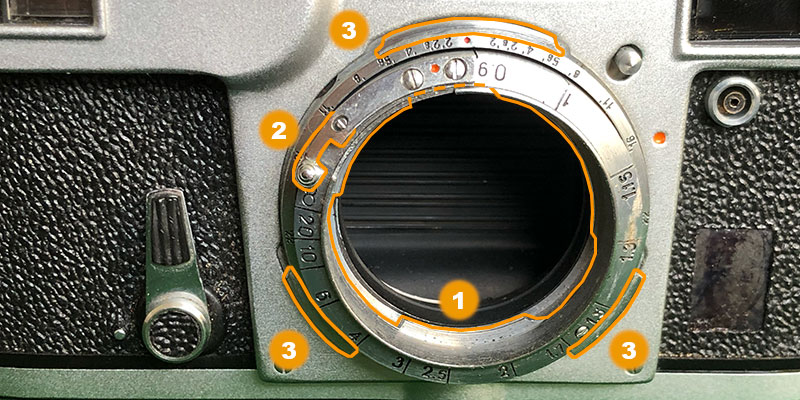
[1] Inner bayonet (three prongs), partly obscured
[2] Inner bayonet hold-down clamp
[3] Outer bayonet (three-pronged)
The inner bayonet on a Contax / Kiev camera is intended to rotate in its entirety (including the lens). The rotating motion is coupled to the rangefinder, while the rotating motion also shifts the lens away from the film plane, thereby facilitating focusing.
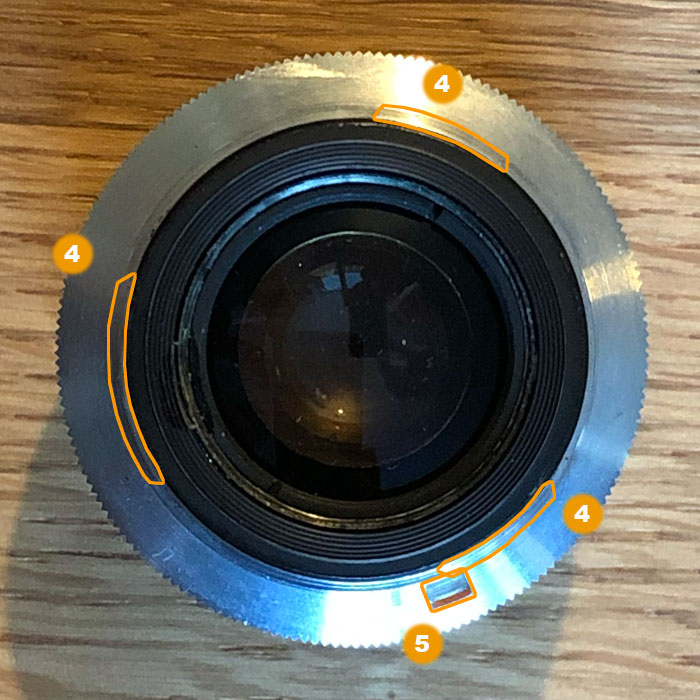
Please note, as the Contax / Kiev inner bayonet rotates, lenses have no real up of down.
[4] Three-pronged bayonet (engages with three-pronged inner bayonet (1))
[5] Inner bayonet lock pin (locks with inner bayonet hold-down clamp (2))
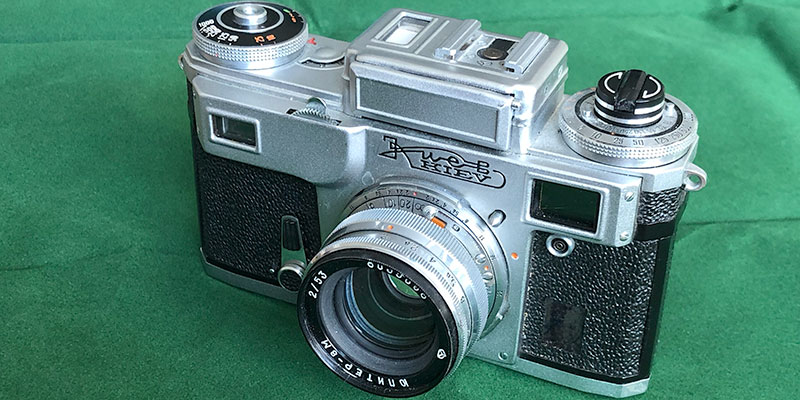
Observe how the lens’ locking pin is grasped by the inner mount’s hold-down clamp.
While simple and elegant, this has three limitations:
a) Firstly, this method of focusing necessitates that the entire lens rotates around the optical axis, meaning that inner bayonet lenses have no obvious “up”. To address this, inner bayonet lenses often have duplicate aperture scales (one on each side of the lens) in the hope that at least one of the scales will be visible whatever the lens’ rotation
b) another obvious limitation is that for the rangefinder to hold true, the relationship between distance increase (exit pupil to film plane) and rangefinder distance scale need to be constant. In other words, this only functions with one focal length (not surprisingly normal lenses were chosen). Lenses of significantly other focal lengths cannot depend on the inner mount.
c) Finally, as for the rangefinder to be able to work independent on which lens is mounted, the rangefinder needs to be set for a specific distance range. In the case of the Contax, a distance range of 0,9 meters to infinity was chosen. This does not mean that shorter distances would be impossible, just that rangefinder coupling cannot work for objects closer than MFD.
Therefore any lens that has a focal length sufficiently different from 50 mm or a lens that is not to be used with the coupled rangefinder must use the outer bayonet. The outer bayonet does not rotate, but if the lens is designed to include an inner barrel that engages with the inner bayonet’s prongs, and rotates in tandem with the lens’ focusing ring a lens mounted on the outer bayonet can still use the rangefinder functionality supplied by the inner bayonet, assuming that the lens’ focusing throw/focusing movement is calibrated to match that of the inner bayonet’s focusing scale (see distance scale on outer edge of inner mount).
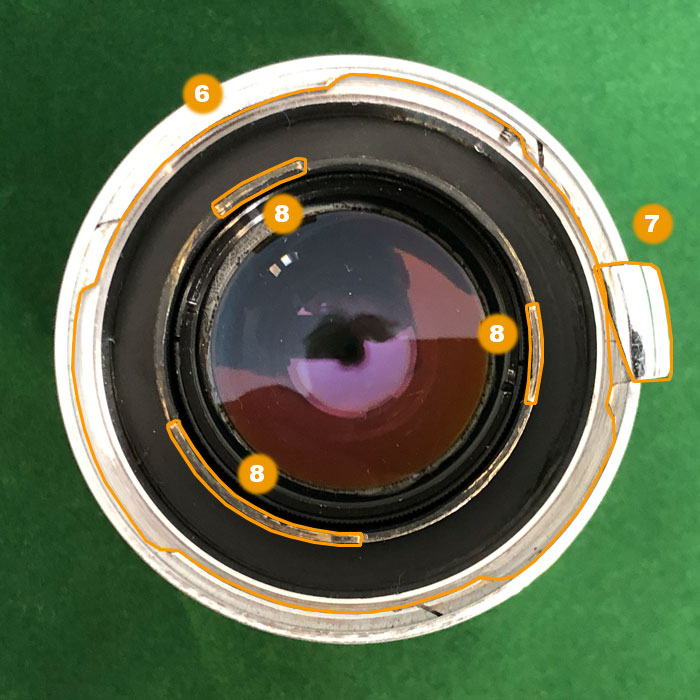
(Lens’ upside at 6 o’clock)
[6] Three-pronged bayonet (clamps onto outer bayonet)
[7] Outer bayonet release clamp
[8] Inner tube (engages with rangefinder mechanism).
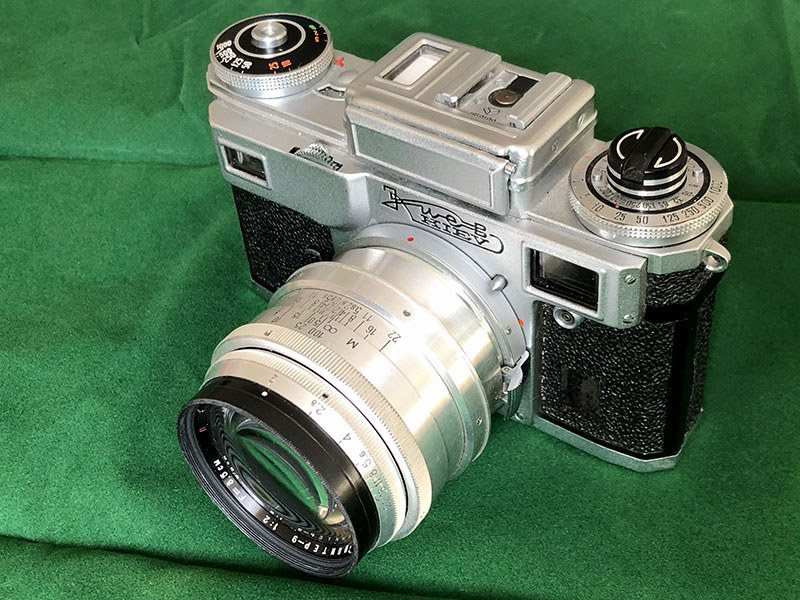
Observe how the lens’ outer bayonet entirely obscures the bayonet mount and distance scale. At the same time, focusing the lens using the lens’ focus ring adjusts the body’s rangefinder mechanism.
While fantastically elegant, especially considering the lens mount’s 1930’s origin, the lens mount does lack some more modern finesses (such as a way for the body to know the lens’ focal length and highlight suitable frame lines in the viewfinder/rangefinder)
Adapting Nikon S mount lenses
Today we most strongly associate post-war Japanese camera prowess with the myriad SLRs that Japanese industry presented the world with, but the simple fact is that the Japanese post-war camera industry started with traditional folding cameras, TLRs and rangefinders. Far before Nikon ever shocked the photo world with the Nikon F professional-grade SLR, Nikon had been learning its trade making rangefinders and rangefinder lenses. In this Nikon’s (and Canon’s and others’) goal had never simply been to emulate Zeiss and Leica, but to try to beat them at what had – until 1945 – been a decidedly German industry. Hence, it is no surprise that the Nikon S mount contains some exceptional pieces of glass (See the following links for some examples: 1 2 3 4). Hence, should you come into possession of Nikon S mount lenses, you will want to adapt them, pronto.
While the Nikon S mount’s flange focal distance (at 34,85 mm) is not as prohibitive as many other rangefinder mounts (28,8 mm for LTM; 27,8 mm for Leica M), it is nigh impossible to adapt Nikon S lenses to SLR’s of any description.
However, when adapting Nikon S lenses to mirrorless cameras, flange focal distances are in your favour. One merely needs a suitable adapter…
Interestingly, that is less straightforward than it sounds, especially if you’ll want to also be able to adapt Nikon S (or Contax / Kiev) lenses that are intended to be used on the internal mount (that do not have a focusing mechanism and depend on the internal mount). While some of the major-brand adapter manufacturers produce Nikon S (Contax / Kiev) adapters, these offer almost only outer bayonet adapters, and these will not allow you to mount any standard lenses. As of this writing (spring 2023) I am aware of only one major-brand Nikon S (Contax / Kiev) to full-frame mirrorless adapter that also offers the internal bayonet. Problematically, that adapter has been out of stock for some time, and was priced at nearly 400 €.
On the other hand, there have been enterprising lens hackers that have used derelict Kiev cameras to manufacture fully functional and quite affordable DIY-adapters for most mirrorless mounts.
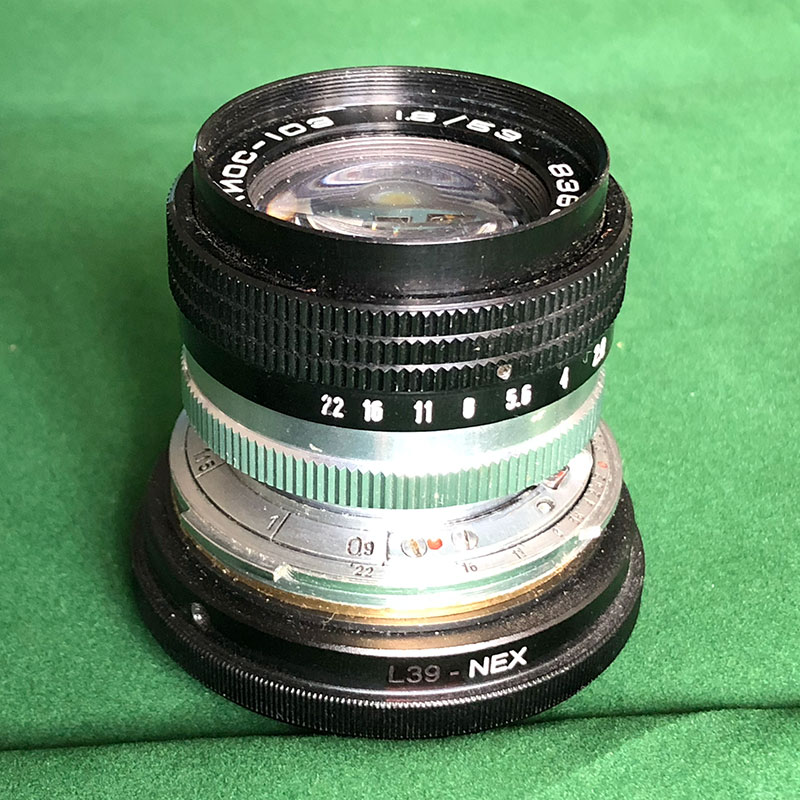
As is plain to see, this adapter is a shotgun marriage of a LTM–>NEX adapter and a Contax / Kiev mount ripped out of a Soviet Kiev camera. Is it elegant? Not unless you’re into brutalism. Does it work? Splendidly. Moreover, this sample’s infinity focus is bang-on, and it supports both inner and outer bayonets.
How about that minor difference between the Nikon S and Contax/Kiev mounts mentioned earlier? Well, that minor difference comes from that the Nikon S body depth actually is 0,31 millimetres shallower than the Contax’ [source]. While – on a real camera (such as when mounting a Contax lens on a Nikon S camera) – this would be an issue as it would quite certainly lead to the rangefinder not giving the right information, one has to ask whether this matters if your intention is to use the lens on a mirrorless camera.
And the answer is: yes of course. There is a ≈0,3 mm difference in the effective flange focal distance between the Contax/Kiev and Nikon S mount, so if your adapter is correctly calibrated for infinity for a Contax/Kiev lens, then if you mount a (correctly calibrated) Nikon S lens on it, and set it to infinity, it will not focus at infinity. Luckily it will then focus a small amount past infinity (so you won’t lose infinity focus ability, just the infinity hard stop).
Footnotes:
1 After WW2, all pre-war patents of German companies were voided. Hence, the Japanese camera industry was fully within its rights to copy German technological innovations. As we all know, this was merely a method for the Japanese industry to bootstrap itself to the next level (their intention never was to ‘just copy’).